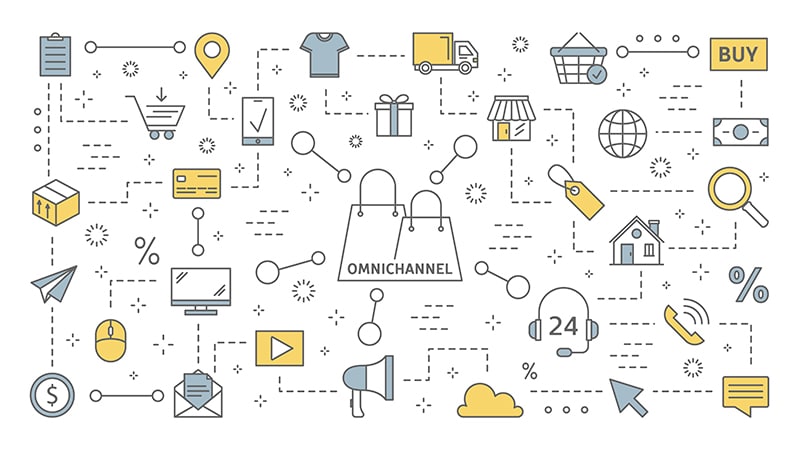We’ve long known that necessity is the mother of invention. 2020 has taught us that pandemics are the mother of rapid adoption. There’s no doubt that what started off as a rather frantic adoption of all sorts of new communications technologies in 2020 – has now become a long term trend as we enter 2021.
Organisations of all sizes have had to modify the way they operate. Keeping up with the latest technological trends was already key to running a successful business as we entered 2020 – the importance of web chat, for example, was identified as key to customer satisfaction back in 2019. But the pandemic pushed customers and consumers into sudden changes in behaviour that businesses had to quickly react to. Whereas digital transformation was dominating the agenda before, now it’s often the only agenda.

So what exactly are “omnichannel” communications?
The term “omni-channel” might already be familiar for communications experts and large businesses, but it may be new territory for small businesses and individuals. It has, however, become a way of life for many of us, without us even realising! Confinement in the home has given everyone aged 8-80 the option to start using a huge variety of ways to keep in touch – be it telephone, email, live chat and video, messaging apps or a range of social media channels. Many of us have become very adept at keeping ‘connected’.
Digital tools such as Zoom have become a lifeline, not just for businesses keeping conversations going with clients and customers, but for individuals seeing friends and family too. So when it comes to business as we enter 2021, many people have come to expect quality customer service from all of these different channels – we crave an ‘omni-channel’ approach.
And why is an “omni-channel” experience important?
Well, as has long been the case, the customer is king. According to US reports, 87% of customers wish that the organisations that they deal with would improve their customer service offering and 35% want to deal with the same representative, regardless of the channel, be it phone, email or chat. An omni-channel customer service offering can create a massive 91% higher customer retention rate year on year.
When it comes to omni-channel communications, many businesses start in-house. Successful business leaders have already taken the opportunity to look at the way that the staff in their organisations are communicating internally. According to KPMG, over half of the CEOs they surveyed said that their own communications with staff had improved during Covid and 77% said that they would continue to build on the use of digital collaboration and communications tools, no doubt having seen how important they are for aligning their workforces.
Once in-house communications have been honed, you can build on how they translate into the public perception and voice of the company. Look at your brand through the eyes of both staff and customers to see how you can create a connection between the two. You’ll then find it much easier to create optimised content for each channel and device that your customers will use. A singular brand experience will allow customers to migrate from channel to channel in a seamless and consistent way, wherever they are in their customer journey, regardless of the avenue of communication. It’s an ideal way to run customer service and sales. Take Amazon customers, for example, who can place and track orders delivered straight to their door, via their laptop, mobile, smartwatch or even an Alexa device.
The challenge is seamlessly connecting the necessary data systems – maybe an existing CRM or similar, so that it can be accessed by all staff, across all devices. As well as this, companies will need to look into simplifying user experience and offer a more personalised service.
Why smaller businesses must keep up
Creating an omni-channel presence is vital for smaller companies who want to keep up with and even rival bigger competitors, particularly in terms of customer service. That’s because customers expect no less. They may not even think about the size of the company when they get in touch, they just want to be able to reach the right person, using their preferred channel and get their issue resolved quickly and efficiently. It may even be that smaller companies have an advantage over larger organisations, as they may not have to contend with cumbersome and unconnected back-office systems that can often hamper omni-channel communications for larger businesses.
We’re better connected than ever before, but many businesses are still slow to embrace this brave new world of communication. We will certainly see the uptake of new and innovative technologies increase as we head into 2021. Live chat, for example, is now ranking as the second most popular channel when consumers contact customer service departments. Ofcom has recently set out a number of objectives to support investment across the UK for all businesses.
As well as keeping staff connected with workplaces and teams in touch, communications technology is also hugely important for business continuity and keeping customers and clients happy. With telecoms and tech at our fingertips it’s never been easier to set up a real-time office experience with a dispersed team. Verbatim’s unique telephone answering service can continue to answer your calls, in your company’s usual way.
Maybe you or your business are wondering how to adapt to a new and more adaptable way of working post-Covid? Why not get in touch to see how our call handling and virtual receptionist services can support your business in a flexible working environment.



